Geotimes

Untitled Document

Travels in Geology
May 2005
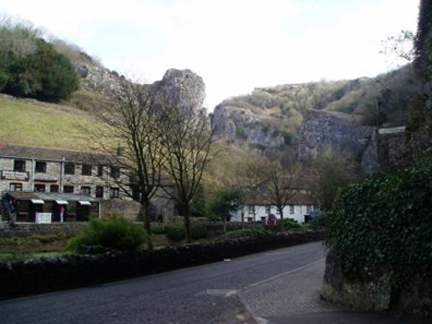 Cheddar
Gorge: Not entirely cheesy
Cheddar
Gorge: Not entirely cheesy
One of the most popular cheeses in the world got its start in a tiny hamlet
at the foot of a gorge in southwestern England. But Cheddar Gorge and the town
of Cheddar in Somerset are actually known for more than just cheese — for
more than 200 years, the area has been well-known because of its geology. With
its guided tours of caves and great hiking trails, the gorge is one of the most
popular tourist sites in England.
Cheddar Gorge in southwestern England
is a terrific day trip for the whole family, including caves, a museum about
human evolution and Stone Age people, and hiking trails. All photos by Megan
Sever.
Getting there is not easy, however. From London, the drive is about 2.5 hours.
From Bristol or Bath — two of the larger cities in the area and good places
to stay if you're exploring Somerset or further into "West Country"
— the drive is only around 20 miles. But it can easily take you an hour
because some of the roads are tiny, easily missed and a throwback to the turn
of the 20th century (you frequently have to stop to let a tractor or a sheep
cross the road). The drive is well worth the trouble and beautiful, and once
you get there, you'll have plenty of time to stretch your legs climbing up "Jacob's
Ladder" to hike around the rim of the gorge.
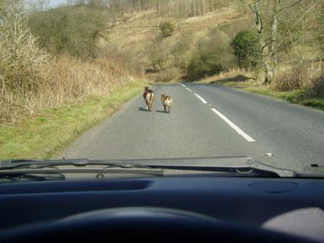 Although
there are few signs, you'll know when you reach the gorge, because what had
been beautiful rolling hills suddenly turns into steep, high gray walls. You'll
start seeing parking areas, or turnouts, when you are still close to a mile
from the show caves and the hiking areas. Keep driving through the gorge and
you'll reach the ticket office (tickets are required to enter the caves and
explore the gorge).
Although
there are few signs, you'll know when you reach the gorge, because what had
been beautiful rolling hills suddenly turns into steep, high gray walls. You'll
start seeing parking areas, or turnouts, when you are still close to a mile
from the show caves and the hiking areas. Keep driving through the gorge and
you'll reach the ticket office (tickets are required to enter the caves and
explore the gorge).
The drive to Cheddar Gorge includes a
foray into days gone by, pausing to let goats and sheep cross the street, or
passing a tractor.
Your ticket to Cheddar Gorge gives you entrance to the show caves and hiking
areas, along with a headset with explanations about the caves. The explanations
seem scientifically accurate, but are quite corny — for example, in one
of the caves, you hear the voice of the man who found the cave 115 years ago,
explaining with a "Crocodile Hunter" level of excitement, how he found
and excavated it. Kids will probably enjoy it, but visitors without kids might
want to skip some of the commentary and get right to the hiking.
Cheddar Gorge is the largest gorge in the United Kingdom and is more than 300
feet deep. Gray limestone forms the steep walls of the gorge and the two limestone
caves that were carved out by Britain's biggest underground river, Cheddar Yeo.
More than 300 million years ago, western England was covered by a warm sea
with a sandstone base. Calcification of dead sea critters and plants formed
a several-hundred-meter layer of limestone. Tectonic movement then forced up
anticlines, the tops of which eroded away to leave sandstone tops and limestone
valleys.
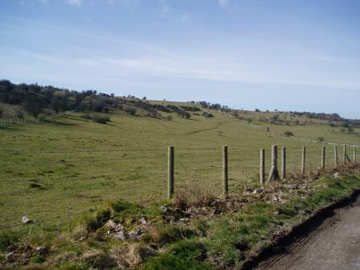 During
the Jurassic, 200 million years ago, a sea once again covered the region, depositing
more limestone. The Mendip Hills area (which are the picturesque rolling hills
you may drive through on the way to Cheddar Gorge) was a level plateau during
this time period. Then about 1 million years ago, ice began taking over most
of the United Kingdom.
During
the Jurassic, 200 million years ago, a sea once again covered the region, depositing
more limestone. The Mendip Hills area (which are the picturesque rolling hills
you may drive through on the way to Cheddar Gorge) was a level plateau during
this time period. Then about 1 million years ago, ice began taking over most
of the United Kingdom.
Ice sheets reached as far south as Cheddar, but the bigger factor in shaping
the landscape was actually the meltwater once the glaciers receded during interglacial
periods. After each ice age, glaciers released a torrent of meltwater through
the Somerset rivers to the sea. Carrying boulders and gravel, the rivers scoured
out gorges like Cheddar Gorge up to 400 feet deep and 3 miles long. Throughout
time, as sea level has risen and fallen, Cheddar Gorge has gotten deeper and
shallower. Along the climb to the ridge of the gorge, you can see various layers
of limestone.
The Mendip Hills in Somerset, seen here
on the drive to Cheddar Gorge, have been extensively shaped by glacial processes
starting 1 million years ago. Today, sheep farms grace the rolling hillsides.
While the surface landscape was being carved by glacial meltwaters, underground
rivers were similarly carving out vast caverns, such as Gough's Cave and Cox's
Cave, the two caves in Cheddar Gorge. Floodwaters and underground rivers dissolved
the limestone, slowly sinking lower and lower until they hit the harder sandstone
layer and leaving caves above.
Cox's Cave, named for George Cox who allegedly discovered it in 1837 when a
mill worker fell through a hole in the cave's roof, is smaller than Gough's
Cave and is no longer being carved out, but curtain-shaped stalactites and fat
stalagmites continue to grow impressively.
Gough's Cave, named after Cheddar resident Richard Gough who discovered and
then dug out the cave around 1890, has more than one-quarter of a mile of stalactite-
and stalagmite-filled caverns to explore and still is being carved by the Yeo.
The cave is perhaps most famous for a more recent find — the 9,000-year-old
body of a man.
Archaeologists believe that "Cheddar Man," as the Stone-Aged hunter-gatherer
is known, and his tribe inhabited Gough's cave. Although the skeleton has been
moved to the Natural History Museum in London for archaeological study, a replica
has been placed in the cave where he was found. Your headset-guided tour includes
Cheddar Man coming back to life to tell you about his life in the Stone Age.
It's a pretty poor voiceover and description and calls for a lot of speculation
(as little is known about these Stone Age people), but kids might like it and
some archaeologically interesting information about how Cheddar Man is believed
to have lived is included.
Interestingly, a couple of years ago, archaeologists found a living relative
of Cheddar Man — a history teacher living right in Cheddar. The two, who
lived more than 9,000 years apart, share mitochondrial DNA, as you learn in
the Cheddar Man Museum, which is across the street from the cave. Renowned paleoanthropologist
Chris Stringer of the Natural History Museum in London lent his expertise to
the evolution museum and it shows. Be forewarned, however, that the museum is
not for the faint of heart or perhaps for young children (even though there
are activities like cave painting that are aimed at youngsters): It includes
some fairly graphic depictions of cannibalism and life in the Stone Age.
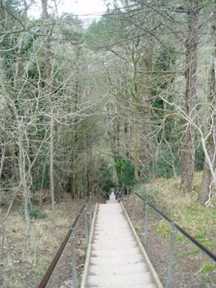 The hokiest
part of the whole site is Crystal Cave, in which visitors have to rescue a crystal
from dark underworld forces in order to save the world. If you're traveling
without kids, you may want to instead go straight to Jacob's Ladder, a grueling
series of 274 steps leading up to the rim of the gorge.
The hokiest
part of the whole site is Crystal Cave, in which visitors have to rescue a crystal
from dark underworld forces in order to save the world. If you're traveling
without kids, you may want to instead go straight to Jacob's Ladder, a grueling
series of 274 steps leading up to the rim of the gorge.
The folks who set up the gorge's tourism wisely put benches every so often
up the hillside, replete with interesting descriptions of the geology at that
level, including tales of what creatures roamed the region during the Carboniferous
and Jurassic, and how the deposition of the sediments worked. Reaching the top
of Jacob's Ladder, visitors may be dismayed to find another set of steps leading
to the top of a lookout tower, from which you can almost see Bristol Bay. The
view is worth the extra steps, and on a warm summer day the breeze will feel
refreshing.
Jacob's Ladder is a series of 274 steps
leading from the base of the gorge up 100 feet to the rim, where hiking trails
begin. Along the steps are benches and signs explaining the geological history
of the area.
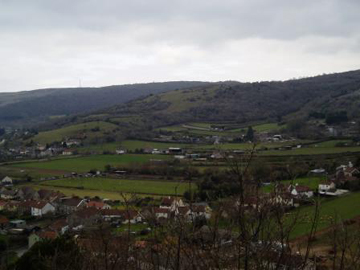 For
those wanting more adventure, a nature trail leaves from the tower and heads
along the rim, dropping you off all the way back down at the foot of the gorge.
It is a several-hour hike on rocky terrain, so bring water if you're going to
do it.
For
those wanting more adventure, a nature trail leaves from the tower and heads
along the rim, dropping you off all the way back down at the foot of the gorge.
It is a several-hour hike on rocky terrain, so bring water if you're going to
do it.
No visit to Cheddar Gorge is complete without stopping by the cheddar cheese
factory, or at least one of the many gift shops that sell local cheese. Visiting
Cheddar requires no more than a day, and in fact can easily be done in a day
with a side visit to nearby Wells, which boasts one of England's oldest and
most beautiful cathedrals, or Glastonbury, which is rumored to be the final
resting place of the legendary King Arthur and Queen Guinevere.
The view from the top of the lookout
tower on the gorge rim is of the rolling Mendip Hills, all the way out to Bristol
Bay on a clear day.
Although Cheddar does have a few places to stay overnight, should you wish
to do so, nearby towns and cities also provide options. In this neck of the
woods, villages pop up every few miles and almost all of them have good Bed
& Breakfasts, along with quaint taverns. Book ahead in the summertime, as
places fill up very fast.
The geology and landscape of southwestern England are quite remarkable, and
vary widely from the rest of England. From Bath or Bristol, visiting the expansive
moors of Exmoor National Park or Dartmoor National Park is just a day's drive,
as is the Devon coast. Cornwall is a tad farther, but the seashores are magnificent.
If you're heading to southwestern England, grab a geology tour book — there
are several good ones out there — and a driving guide, and head for the
hills.
Megan Sever
Links:
Cheddar
Gorge historical and tourist information
Somerset
tour guide
Listing
of B&Bs in "West Country"
Travels in Geology
Back to top
Untitled Document

 Although
there are few signs, you'll know when you reach the gorge, because what had
been beautiful rolling hills suddenly turns into steep, high gray walls. You'll
start seeing parking areas, or turnouts, when you are still close to a mile
from the show caves and the hiking areas. Keep driving through the gorge and
you'll reach the ticket office (tickets are required to enter the caves and
explore the gorge).
Although
there are few signs, you'll know when you reach the gorge, because what had
been beautiful rolling hills suddenly turns into steep, high gray walls. You'll
start seeing parking areas, or turnouts, when you are still close to a mile
from the show caves and the hiking areas. Keep driving through the gorge and
you'll reach the ticket office (tickets are required to enter the caves and
explore the gorge).
 Cheddar
Gorge: Not entirely cheesy
Cheddar
Gorge: Not entirely cheesy
 During
the Jurassic, 200 million years ago, a sea once again covered the region, depositing
more limestone. The Mendip Hills area (which are the picturesque rolling hills
you may drive through on the way to Cheddar Gorge) was a level plateau during
this time period. Then about 1 million years ago, ice began taking over most
of the United Kingdom.
During
the Jurassic, 200 million years ago, a sea once again covered the region, depositing
more limestone. The Mendip Hills area (which are the picturesque rolling hills
you may drive through on the way to Cheddar Gorge) was a level plateau during
this time period. Then about 1 million years ago, ice began taking over most
of the United Kingdom.  The hokiest
part of the whole site is Crystal Cave, in which visitors have to rescue a crystal
from dark underworld forces in order to save the world. If you're traveling
without kids, you may want to instead go straight to Jacob's Ladder, a grueling
series of 274 steps leading up to the rim of the gorge.
The hokiest
part of the whole site is Crystal Cave, in which visitors have to rescue a crystal
from dark underworld forces in order to save the world. If you're traveling
without kids, you may want to instead go straight to Jacob's Ladder, a grueling
series of 274 steps leading up to the rim of the gorge. For
those wanting more adventure, a nature trail leaves from the tower and heads
along the rim, dropping you off all the way back down at the foot of the gorge.
It is a several-hour hike on rocky terrain, so bring water if you're going to
do it.
For
those wanting more adventure, a nature trail leaves from the tower and heads
along the rim, dropping you off all the way back down at the foot of the gorge.
It is a several-hour hike on rocky terrain, so bring water if you're going to
do it.